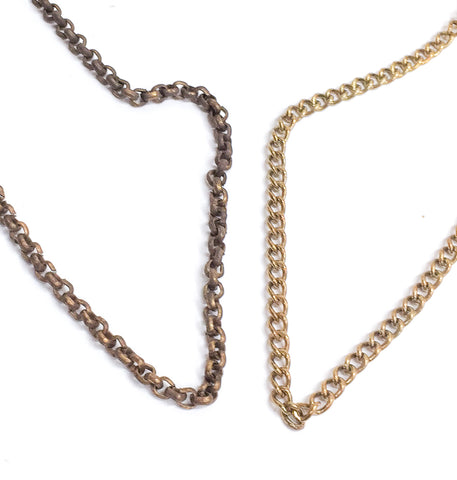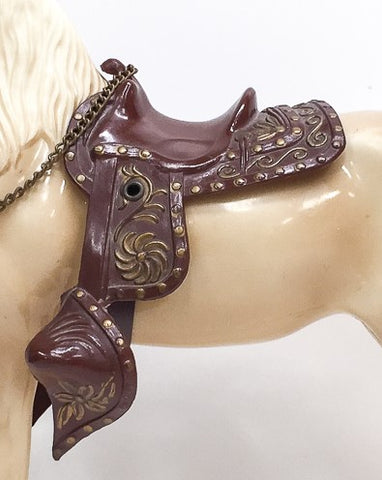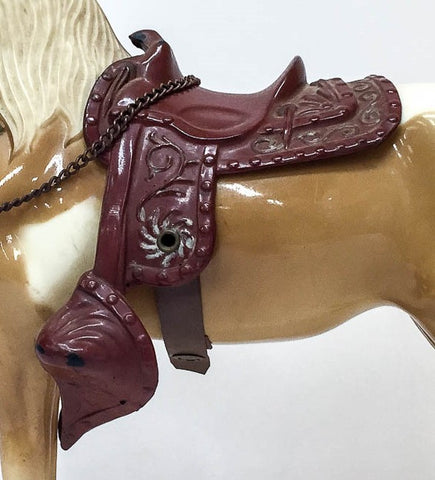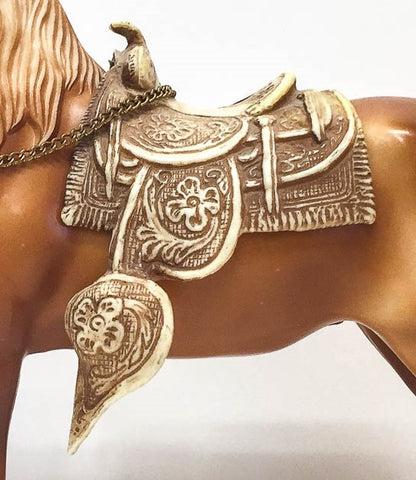Breyer's Western Horse is its most recognizable mold, and its very first. Almost every collector has at least one, and many actively collect them, seeking out not only all the colors, but all the variations of color and tack styles. We'll be doing a special tribute to the Western Horse in June, with over 30 models going live over two Fridays during the month! (Click here to see the models when they are listed on June 1 and June15!)

Says Anni from Michigan:
I love the Breyer Western Horse tribute! My first Breyer was the Palomino Western Horse! Her name is Sugar and my Mom gave her to me while I was in the hospital fighting pneumonia. It was back in 1968 or 69. Sugar still stands proudly in my "Breyer Room" as the matriarch.
Eleda's first Western Horse also has a story:
I was a teenager, out on a camping trip with my older sister, and we decided to take a trip into town. We went into a little antique shop to see if there were any horses that needed a home, and she spotted a beat-up palomino Western Horse on a shelf - no saddle, no reins. I didn't collect the mold at the time, and it wasn't worth half what they were asking, but she was so excited that she had found me a Breyer that I bought him and let her name him for me. She passed away unexpectedly just a few years later, so "El Dorado" is a treasured member of my herd, holding a very special memory of my sister. He became the overseer of a growing conga of Western Horses and Ponies in my collection.
You may notice that one collector considers hers a mare while another considers hers to be male. In fact, the mold is genderless, lending it to whatever gender you wish to assign.

Take a trip with us through the history of Breyer's first animal mold and it's longest-running release. Changes to tack, colors, and even the mold itself make this a fascinating model to collect and a treat for Breyer history buffs.
Breyer began making Western Horses in 1950. These earliest horses were sold to MasterCrafter and mounted on bases with MasterCrafter clocks. Beginning in 1951, the horses were available for sale by themselves for the first time. That first year, a white horse and a palomino were offered, called "Western Mount Horses." Eventually that was shortened to Western Horses, and like all Breyer models, more colors were introduced over time, including a solid black, a black pinto, and a palomino pinto. The most popular of all, though, continued to be the palomino, who became Breyer's longest-running release, continuing for forty years, through 1991!

Every release that continues for a long period will experience changes over time, plus accidental variations. This is probably true nowhere more than with the Western Horse, since it was their first foray into animal molding. They had a lot of learning and refining to do, so collecting these guys is like taking a walk through Breyer history. The first mold by Breyer was a pretty close copy of the Hartland Western Horse. Before long, the mane on the Breyer was moved to the opposite side and the diamond conchos that copied Hartland were changed to round conchos.
In the beginning, Breyer also followed Hartland by using the same style reins. Known to collectors as O-link reins, they were made of what look like hand-made metal rings. In 1953 they changed to the twisted bracelet-link reins still in use today.








4 comments
I have a friend who has a very heavy model horse with a gold saddle . The horse is dark brown ,.. it was bought at a pawn shop around 39 yrs ago ., it’s in excellent shape ., I was wondering if anyone would know anything about such an item …
I have loved Breyers, and Hartland rider sets, since I was old enough to appreciate them-I was born in 1954. My sister and I played with them for hours. It was my misfortune to be the second horse-loving daughter. My mother wouldn’t help me collect horses of my own because my sister already was. She made me collect dogs. I was resentful my entire life.
Years went by and one day I was browsing through an antique shop and spotted high up on a shelf a traditional black tobiano Western Horse. No saddle, no reins, some scratches, but beautiful none-the-less! I loved him instantly. I began collecting them now and again, and when my children came along, bought them as gifts for them as well. Then as my girls grew older the money went for basketball and theater.
Now they’re grown and my Breyer and Hartland collecting had exploded (thanks to the internet…).
The decorator models are incredible! But my first true loves are the Traditional Western Horses! I feel like a kid in a candy store when I find one with O-rings or some uncommon variation. I’m glad there are other collectors out there with upwards of hundreds of this model alone-makes me feel less like a crazy person!
They are a very special part of my life.
I saw a link to this article on a Facebook page and thought I’d check it out…then saw my name in the ‘comments’ section, so thought I’d pipe in by saying this is a good article that might pique someone’s interest into collecting Breyer Western Horses or collecting more of them.
Yes, I do have a collection of Western Horses, somewhere between 150 and 200 of them, with no two alike. It’s the many variations of this mold that is one of my reasons for having collected them since the early 70s. The other reason is sentimental…my first two Breyers were Western Horses— the palomino and a black pinto (with cinchless saddle), which brings me to say that I’m not convinced that the cinchless saddles were first or only used on the clock horses as I had bought a brand new Western Horse (the black pinto) that came with a black-washed cinchless saddle. I still have that horse, as well as the palomino, with their original saddles. Some years later, I had bought another black pinto with the same cinchless saddle on it.
As with the horses and saddles, and as you had mentioned in this article, the reins came in two obvious variations- the O-link and twisted link, but the O-link reins had variations of their own…they were made of various metals: brass, copper alloy and steel. I do believe the brass were the most commonly used, followed by the copper alloy then the steel. I can only imagine that the steel reins are hard to come by nowadays due to them having had rusted away. I consider myself very lucky to have at least one very nice set of original steel O-link reins.
This article mentions early palominos having had “sooty grey-brown shading in their manes and tails”, but it was more common to see some of the white Horses having brown-washed manes and tails (that was often mistaken for dirt and, in turn, washed off). My earliest white Western Horse (which really isn’t ‘white’ as much as it is off-white or ivory) has brown-washed mane and tail, but also brown shading around the dark brown eyes, insides of ears, and nostrils. The hooves are dark brown…like the eyes. It wears a buckled saddle, O-link reins and a bar bit (not the common wire bit).
Another oddity that I picked up from a non-hobbyist, who was the initial buyer of the Horse, is a Horse made of black plastic with painted-on white socks, stenciled white blaze, and grey hooves…and gold tack (not silver like you might expect). Details include eye whites and hand-painted black forelock. It has the common brass twisted-link reins and black with gold snap saddle. The original owner of this Horse said she bought it from Montgomery Wards back in 1957 at Christmas time. She bought it off the store shelf…it didn’t come in a box, but she couldn’t remember if it was some sort of Special Edition or not. Too bad we aren’t able to post photos with our comments…..
I hope you don’t mind a correction to the above info. Breyer Western Horses have always had the round conchos only and Hartlands always had the diamond-shaped. That is actually the easiest way to tell them apart. And the early Hartlands had the mane on the same side as the Breyers, so you can’t go by which side the mane is on. You can also tell them apart by the hooves, which are more rounded or convex on the Breyer and have a straight profile on Hartland. See Mike Jackon’s Hartland page for detailed information on the clock horses by both Hartland and Breyer. (there’s a photo on there showing the difference in the hooves) http://www.myhartlands.com/pages/MastercraftersClocks.html There is a Clock Horse Research Group that researched this information in depth. I was in the most recent version of the group myself. Sande Schneider (also in the group) is a great source for information on Western Horses. She has a Facebook page called Vintage Horse and Rider Sets; I have one called Western Horse and Pony Lovers. There are tons of great photos and info on both pages. Between us we have hundreds of these horses and ponies — we love them! :) (Susan Tank, also on the committee, has a really huge collection of WHs too with many variations.) Sande has been in the hobby a very long time and knows a lot of details and history about both Breyers and Hartlands — and about rider sets. She was friends with Nancy Young, and Nancy was also involved with the Clock Horse Research Group. Some of the discoveries they made came out after her books were published. BTW the earliest Hartland horses of this style were called “Victor” and later ones are “Champ.” Love that you’re doing this. The WH doesn’t get enough attention … which is why we started our Facebook pages.